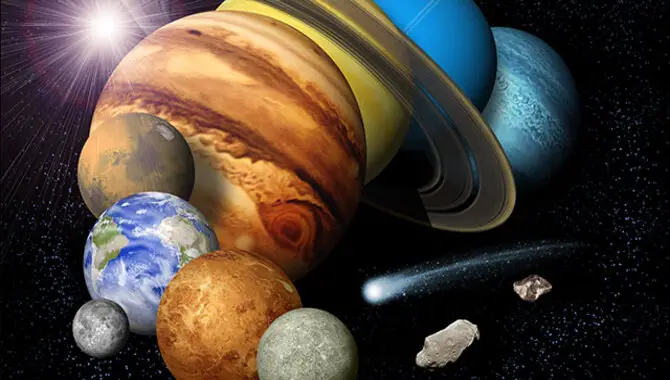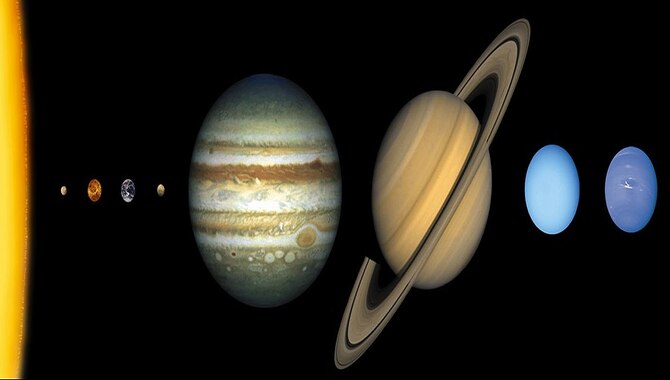Making a model of the solar system is a great way to learn about the planets and their order from the sun. It can be used for a school project, a science fair, or fun.
There are many ways to make a model of the solar system, but one easy way is to use a styrofoam ball as the sun and then glue or tape small, round objects to represent the planets. You can find small styrofoam balls at most craft stores.
Once you have your sun, you must decide how big you want your solar system to be. You can make it to scale or make the sun larger and the planets smaller so that they will all fit on your styrofoam ball.
Once you have your sun and planets, you must decide how to order them. The planets orbit the sun, so you must start with Mercury, closest to the sun. Then comes Venus, Earth, Mars, Jupiter, Saturn, Uranus, Neptune, and Pluto.
You can use a ruler or a string to measure the distances between the planets and the sun or estimate them. Once you have all your planets, you can add stars by poking small holes all over your styrofoam ball.
Your solar system model is now complete! You can display it on a shelf or a table or hang it on the ceiling.

What Materials Will You Need To Create Your Model?
When it comes to creating a model, there are a few things you will need. Here is a list of materials you will need to create your model:
- A base: This can be a piece of cardboard, a block of wood, or anything else that will provide a sturdy foundation for your model.
- Scissors: You will need scissors to cut out the pieces of your model.
- Glue: Glue will be used to attach the pieces of your model.
- Paint: Paint can add color and detail to your model.
- Paper: Paper can be used to create templates for your model.
- Tape: Tape can secure paper templates for your base.
- X-Acto knife: An X-Acto knife can cut out intricate pieces of your model.
Now that you know what materials you need, look at an example. Let’s say you want to create a model of a house.
- First, you will need to gather your materials. You will need a base, scissors, glue, paint, paper, tape, and an X-Acto knife.
- Next, you will need to create a template for your house. You can do this by tracing the outline of your house onto a piece of paper. Once you have your template, you can use tape to secure it to your base.
- Now, you will need to start cutting out the pieces of your house. You can use scissors or an X-Acto knife to do this. Once all of your pieces are cut out, you can start assembling your house.
- First, you will need to glue the walls of your house to the base. Once the walls are in place, you can add the roof. Once the roof is in place, you can start painting your house.
- You can add as much or as little detail to your house as possible. Once you are finished painting, your house is complete!
What Is The Best Way To Represent The Sun And Planets In Your Model?

There are many ways to represent the sun and planets in your model, but the most important factor is ensuring the model is to scale.
The sun is about 109 times Earth’s size and about 93 million miles away from Earth, so it is important to ensure that your model reflects these proportions.
One way to represent the sun and planets in your model is to use a globe for the sun and small balls for the planets. Using string or wire, you can then place the planets in orbit around the sun. This will give you a basic understanding of the sun’s and planets’ relative sizes and distances.
Another way to represent the sun and planets in your model is to use a light bulb for the sun and small balls for the planets. Using string or wire, you can then place the planets in orbit around the sun. This will give you a basic understanding of the sun’s and planets’ relative sizes and distances.
A third way to represent the sun and planets in your model is to use a small ball for the sun and small balls for the planets. Using string or wire, you can then place the planets in orbit around the sun. This will give you a basic understanding of the sun’s and planets’ relative sizes and distances.
Whichever way you choose to represent the sun and planets in your model, the most important factor is to make sure that the model is to scale.
How Can You Accurately Depict The Planet Sizes And Distances In Your Model?

Most people have a general understanding of the relative sizes of planets and how far apart they are. Still, when it comes to creating a solar system model, it’s important to be as accurate as possible. Here’s a step-by-step guide to making sure your model accurately depicts the sizes and distances of the planets:
- Do your research: The first step is to make sure you understand the planets’ sizes and distances. This means doing some research and consulting reliable sources.
- Choose a scale: Once you understand the relative sizes of the planets and their distances from the sun, you need to choose a scale for your model. This will determine how big or small each planet will be in your model.
- Get the proportions right: Once you’ve chosen a scale, it’s important to ensure the planets’ proportions are accurate. This means that the size of each planet in your model should be in proportion to its size in real life.
- Get the distances right: The final step is to ensure the distances between your model’s planets are accurate. This means measuring the distances between each planet and ensuring they’re proportionate to real-life distances.
Creating an accurate solar system model can be a fun and educational project. By following these steps, you can ensure your model is as accurate as possible.
How Will You Label Your Model To Ensure Others Understand Your Solar System?

In any scientific endeavor, it is important to label your work clearly so that others may understand and replicate your findings. When building a solar system model, be sure to label the sun, planets, and other relevant features.
A good way to do this is to use the symbols for each body as they are typically seen in astronomy textbooks. For example, the sun can be represented with a big yellow circle, while Mercury may be a small gray circle. Be sure to include all the planets from the sun: Mercury, Venus, Earth, Mars, Jupiter, Saturn, Uranus, Neptune, and Pluto.
Other things that can be helpful to label on your model are the planets’ orbits. You can use dashed lines to indicate the elliptical paths that the planets follow around the sun.
It can also be helpful to include the planets’ axial tilts, represented by small lines coming off the planets’ poles. Finally, don’t forget to label the model with your name and the date!
Here is an example of a labeled solar system model:
Solar System Model
by John Smith
1/1/2020
Sun: ☉
Mercury: ☿
Venus: ♀
Earth: ♁
Mars: ♂
Jupiter: ♃
Saturn: ♄
Uranus: ⛢
Neptune: ♆
Pluto: ♇
Orbits:
Mercury: ●
Venus: ●
Earth: ●
Mars: ●
Jupiter: ●
Saturn: ●
Uranus: ●
Neptune: ●
Pluto: ●
Axial Tilts:
Mercury: /
Venus: /
Earth: /
Mars: /
Jupiter: /
Saturn: /
Uranus: /
Neptune: /
Pluto: /
What Is The Best Way To Display Your Model Once It Is Complete?
There are a few things to consider when displaying your model:
1. Where will it be Displayed? Indoors Or Outdoors?
2.How Big Is The Model?
3. What Is The Purpose Of The Display (E.G., Educational, Decorative, Etc.)?
4.What Materials Will Be Used?
5. How Much Time And Effort Do You Want To Put Into The Display?
Once you have answered these questions, you can start planning your display.
Here are a few tips:
- Use a base or platform to elevate the model and make it more visible.
- Use lights to highlight the model and make it more eye-catching.
- Use props to add realism or create a theme (e.g., trees, people, buildings, etc.)
- Use signage to explain the model or add interest (e.g., labels, diagrams, etc.)
- Be creative! There are endless possibilities when it comes to displaying a model.
Here is an example of a model display that is both eye-catching and informative: This solar system model is displayed on a black base with white lights shining on it from all sides. The planets are labeled, and a yellow light represents the sun. The display is encased in a clear plastic box to keep everything clean and dust-free.
